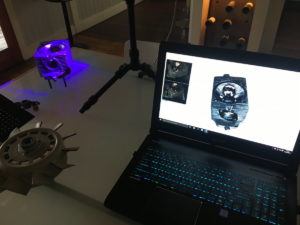The 3D printer has been fantastic for prototyping and checking CAD parts before I send them to the CNC for production. It has saved countless hours on designing parts like the roller tip rockers for the Lycoming engine. Changing motion ratios and optimising the tip geometry couldn’t have been done easily or as quickly any other way without a complete and accurate 3D model of the cylinder and other critical parts.
The parts still needed to be created on CAD with no accurate reference to the original part. Until now! Parts like the standard Lycoming rocker couldn’t easily be measured with my digitising probe or the camera loaded into the CNC so I have been exploring other options…
Metrology grade 3D scanning can easily be outsourced these days but the time and cost of relying on other companies is just painful – I haven’t had much luck with either! After a bit of research and a few trials I settled on a fairly new release to the market which on specification seemed to fit my requirement nicely.
I haven’t had a huge amount of time to play with the scanner yet but the first results seem really promising, especially with the automated turntable. I scanned in the standard Lycoming rocker to see the quality of the model which made measuring the standard angles and dimensions really easy. As a test, I also scanned in one of my 3D printed roller tip rockers. I sent the resulting model to the printer to compare the scanned model with the original and amazingly, there were no real differences that could be measured with a vernier caliper! Pretty impressed with that! The advertised resolution drops off when scanning larger parts like body panels but I haven’t tried that yet.
I tried a twin plug 911 head that was lying around to see if my dreams of easily making a billet head were going to come true, but it seems there isn’t a lazy option with the complex geometries. The resolution is amazing with the texture camera. You can see every little surface mark, but I really need spend a bit more time with the scanning technique. It looks a lot easier in the sales video! What they don’t also tell you in the sales video is that after the initial purchase, you need to spend the equivalent cost of a car again on yet more software to make it easier to create the solid model from the scanned model so the scan is useful for actual reverse engineering. Otherwise it is only really good for making high resolution bobbleheads and simple changes to existing parts.
I know there are a few motorsport teams that are using this scanner now so it will be interesting to see how it works out for me!


